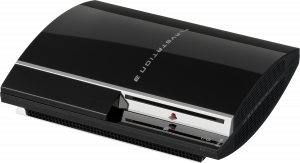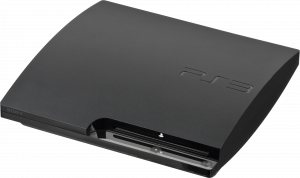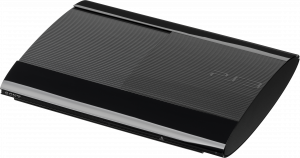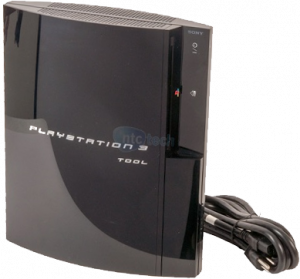PS3:Buying Guide
This page serves as a reference for information on each model of the PlayStation 3. These are all objectively based recommendations, with no bias for the appearance of the console. Acronym definitions can be found on the FAQ page.
While this page mainly focuses on retail consoles (CECH), most characteristics of retail models will also apply to DECH (TEST) hardware and vice versa.
| Many NOR consoles (CECH-L to CECH-21XX) can come with Samsung K8Q2815UQB-PI4B NOR chips, which tend to have a higher chance to RSOD (however, this is usually rare even with Samsung NOR). RSODs cannot be fixed unless you have CFW and/or replace the NOR flash chip. Consoles can also come with Spansion or (on Slim) Macronix NOR chips, which tend to be more reliable. |
PlayStation 3 (2006-2009)
The original versions of the PlayStation 3 can be distinguished by the large "PlayStation 3" branding on the top shell, entirely glossy finish, and the thicker/rounder shell.
The early first generation versions of the PS3 feature hardware-based PS2 backward compatibility, four USB-A ports on the front, HDMI 1.3 output, memory card readers for SD, miniSD, Memory Stick PRO, and Compact Flash, chrome trim, the multi-AV port shared with the original PlayStation and PlayStation 2, Super Audio CD playback, and S/PDIF optical audio output. CECH-B models had all black trim instead of chrome with no Wi-Fi connectivity and memory card readers, but are otherwise the same. These unique characteristics make it easy to identify a PS3 with PS2 hardware, in addition to them having much more case airflow.
Later second/third generation versions of the PS3 removed two USB ports, the memory card readers, SA-CD support, and PS2 hardware. The chrome trim was also changed to a matte silver finish, but the rest of the I/O is the same.
Since it's the oldest version of the PS3, they tend to have the highest power consumption compared to the Slim and Super Slim, especially when comparing the early models with PS2 hardware. Some early models which were sent into Sony repair centers may have a 65 nm or 40 nm RSX.
All original PS3s have a Blu-Ray daughterboard paired to the motherboard, but new daughterboards can easily be paired with custom firmware.
First Generation Retail SKUs
| All first generation fat consoles have a very high YLOD risk; proceed with caution if you commit to buying one. |
| Model | Description | CELL | RSX | Default HDD Size | Motherboard | MinVerChk |
|---|---|---|---|---|---|---|
| CECH-A | First PS3 console released. Features full hardware-based PS2 backwards compatibility (EE+GS CPU/GPU, IOP, and RAM) alongside four USB ports, two 128MB NAND flash chips, multiple card-reader ports, and the ability to play SA-CDs. Released in the U.S., Canada, and East Asia. | 90 nm CXD2964 | 90 nm CXD2971 | 60GB | COK-001 | 1.00 |
| CECH-B | "Lower-end" version of the CECH-A. Came with a 20GB HDD, no card readers, and no Wi-Fi. Unlike other first gen fat models, this model replaced the glossy chrome trim with a glossy black finish. This model was also only released in the U.S., Canada, and East Asia. | 20GB | ||||
| CECH-C | First console to have PS2 hardware for backwards compatibility (Emotion Engine CPU, IOP, and RAMBUS) removed and instead have these functions emulated by the PS3's CELL CPU. Only the PS2's Graphics Synthesizer remains. First PS3 to be released in Europe and Oceania, but wasn't released in North/South America or Asia. PSUs in these models only operate at 220V-240V unless replaced. | 60GB | COK-002 | |||
| CECH-E | Refresh of the CECH-C, but with an upgraded HDD. First PS3 to be released in Latin America, and replaced the CECH-A in all NTSC regions except for Japan, as Japan kept CECH-A/B models longer than other regions. In some cases, the CECH-E might have a COK-002W motherboard, indicating that it has been refurbished. | 80GB | COK-002 or COK-002W | 1.00 / 2.70 / 3.40 |
Second Generation Retail SKUs
| Model | Description | CELL | RSX | Default HDD Size | Motherboard | MinVerChk |
|---|---|---|---|---|---|---|
| CECH-G | First console to have the PS2 backwards compatibility chips completely removed, as well as two USB ports, the card reader ports, and the ability to play SA-CDs. The cooling system was also redesigned to be much cheaper, and the case has less airflow. The glossy chrome trim on this model and all future fat PS3s was also changed to a matte silver finish. Due to the 90 nm RSX having flawed underfill chemistry and the removal of front intake vents, this model is very likely to suffer from YLOD unless the GPU is replaced with a 65 nm or 40 nm RSX from a later fat or Slim. The bottom case can also be slightly modified to have extra intake on the side, like in this example. First PS3 to be released globally. PSUs in PAL versions are only 220V-240V unless replaced. Some refurbished CECH-Gs can come with a DIA-002 motherboard. Avoid this console. | 65 nm
CXD2981 |
90 nm CXD2971 | 40GB | SEM-001 or DIA-002 | 1.90 / 1.97 / 2.30 |
| CECH-H | First console to use a 16MB NOR flash instead of two 128MB NAND flash chips. PSUs found in PAL CECH-H PS3s were also switched to universal voltage instead of only 220V-240V like in CECH-C/G consoles. Since these have the same RSX and case design as the CECH-G, CECH-H consoles also have a high YLOD risk, in fact it is even higher than the CECH-G due to having even worse heatsinks. Avoid this console. | 40GB | DIA-001 | 1.97 / 2.30 | ||
| CECH-J | First console to feature a 65 nm RSX. Only released in Europe & Oceania. | 65 nm
CXD2989 |
65 nm CXD2982 | 40GB | DIA-002 | 2.30 |
| CECH-K | Similar to CECH-J, but with an 80GB hard drive. Released worldwide. | 80GB | DIA-002 | 2.16 / 2.30 | ||
| CECH-M | Similar to CECH-H, but only released in the UK & Ireland. The existence of this system is peculiar, as it released after the CECH-L but uses the older DIA-001 motherboard with the second generation chassis. Some users have speculated it comes with a VER-001, but this is not confirmed.
This revision tends to be uncommon, but these consoles should still be avoided due to the 90 nm RSX. |
65 nm
CXD2981 |
90 nm CXD2971 | 80GB | DIA-001 | 1.97 / 2.30 (?) |
| CECH-Q | Similar to CECH-H/M, but only released in Japan with a larger HDD. Included in the Final Fantasy VII Advent Children limited edition console bundle. It is preferred to avoid this console due to it having a 90 nm RSX. | 160GB |
Third Generation Retail SKUs
| Model | Description | CELL | RSX | Default HDD Size | Motherboard | MinVerChk |
|---|---|---|---|---|---|---|
| CECH-L | The original third generation fat console. 65 nm GPU received a new revision, and the case/motherboard design was changed. Some consoles also came with larger CPU/GPU heatsinks. | 65 nm
CXD2990 |
65 nm CXD2991 | 80GB | VER-001 | 2.30 / 2.45 |
| CECH-P | Similar to CECH-L, but with a larger capacity hard drive. North American units were bundled with Uncharted: Drake's Fortune, and European units were bundled with four PSN titles. | 160GB | 2.45 |
PlayStation 3 Slim (2009-2012)
As an effort to drastically rebrand the PlayStation 3, Sony released the PlayStation 3 Slim in 2009. It is significantly redesigned compared to the original models while being slimmer, but the length of the console was oddly increased. It can be identified by its sleek appearance, more minimalist "PS3" branding on the top of the shell, and the shell having a matte finish. CECH-30xx Slims can also be identified by an embossed Sony logo on the front of the system, whereas all the 2xxx Slims had a printed logo. Introduces multiple variants of consoles, distinguished by "A" or "B" in the model number and different hard drive sizes.
The first CECH-20xx models of the Slim featured a die shrunken 45 nm CELL, whereas the RSX was shrunken to 40 nm on the CECH-21XX series models. Naturally, the cooling system was redesigned from the original PS3 to be cheaper to produce. This was the first PS3 that supported HDMI-CEC, which continued to be a feature in Super Slims and all future PlayStation consoles. This model was also the first to remove official OtherOS support, even with OFW older than 3.21. However, OtherOS can be still restored with various CFWs using OtherOS++.
CECH-20xx and 21xx Slims have a Blu-Ray daughterboard paired to the motherboard, but new daughterboards can easily be paired with custom firmware. The CECH-25xx and 30xx also integrate the daughterboard hardware in the motherboard, so it is less likely they will have Blu-Ray related issues. Swapping the Blu-Ray drive on these models and any Super Slim PS3 also no longer requires Factory Service Mode to remarry a new drive.
IMPORTANT NOTE FOR CFW ON CECH-25XX MODELS: Consoles produced circa April 2011 and later are known to have an updated hardware encryption key (metldr2) and a MinVerChk of 3.60, and therefore cannot use CFW. A quick way to check if the console is exploitable is by looking at the manufacturing date if it's before April 2011 (NTSC-U consoles) or the datecode for a 0, 9, or 1A (PAL consoles) on the bottom sticker. This method will not work on NTSC-J consoles, as they don't show the manufacturing date.
Consoles made between January and April 2011 (1A Datecode) usually can't be downgraded to 3.55, but can still use CFW with a noFSM patch, as they still have the old encryption key. The consoles that fall into these date ranges can be patched to install CFW. For consoles made during or after this date, you can check if it is patchable by running MinVerChk or Bgtoolset on the console to ensure it reports 3.56 or below.
Retail Slim SKU Comparison
| Model | Description | CELL | RSX | Default HDD Size | Motherboard | MinVerChk |
|---|---|---|---|---|---|---|
| CECH-20XX | Slim launch model. First console to feature a 45 nm CELL, and replaced the NEC/TOKIN capacitors used on the CPU with standard tantalum capacitors.
When looking for a Slim PS3, you may want to avoid this model if possible due to the 65 nm RSX having far too much heat output in this model unless it is delidded. |
45 nm CXD2992 | 65 nm CXD2991 | 120GB(A) or 250GB(B) | DYN-001 | 2.70 |
| CECH-21XX | Second model of slims released. First console to feature a 40 nm RSX and replaced the NEC/TOKIN capacitors for the GPU with standard tantalum capacitors. The 40 nm RSX on this model and all future Slims have much stronger thermal plaster on the VRAM modules, making delids of them much harder to do. The power supply was changed to be lower wattage, as the new RSX doesn't need as much power. The case was also changed slightly. Intriguingly, the YLOD sequence was slightly altered to not have a yellow light flash during the sequence, but will still show the flashing red light and play a triple beep sound. | 45 nm CXD2992 | 40 nm CXD5300 | SUR-001 | 3.20 / 3.40 | |
| CECH-25XX | Third model of slims released. Last models to support the installation of CFW; read the note for more information. The Blu-Ray drive controller is embedded in motherboard, reducing the possibility of needing No-BD firmware if the Blu-Ray drive is defective. The shell was also changed, making older motherboards requiring slight modification to fit in shells from this model. The CXD2992BGB CELLs on this model use much more sealant and have black plastic spacers between the interposer and IHS, making CPU delidding on this model and the CECH-30XX are much harder than 90 nm or 65 nm CELLs as a result. | 45 nm CXD2992 | 40 nm CXD5300 | 160GB(A) or 320GB(B) | JSD-001 or JTP-001 | 3.40 / 3.50 / 3.56 / 3.60 |
| CECH-30XX | Fourth model of slims released. Does not support installation of CFW. Still has a plug-and-play Blu-Ray drive like the CECH-25XX models. The shell, motherboard, Blu-Ray drive, and power supply are exclusive to this model and cannot use parts from older model Slims. | 45 nm CXD2996 | 40 nm CXD5301 | KTE-001 | 3.60 / 3.65 / 3.66 / 3.72 / 4.10 |
PlayStation 3 Super Slim (2012-2016)
The PlayStation 3 "Super Slim" was the last style of the PS3 released. It can be distinguished from the other models by its unique two-tone matte and glossy finish on the top shell with a ridged design on the matte part.
It was further reduced in size from the original Slim, and the RSX no longer has an IHS. This was the first PS3 that introduced internal eMMC storage on the 4xxxA models, and these eMMC models didn't come with a hard drive caddy as it was sold separately.
Later in the Super Slim's production, Sony produced a new RSX revision with a 28 nm process. It changed its VRAM configuration to be 2x128 MB instead of 4x64 MB chips. They do not appear to be much more efficient than the older Slim models. The 28 nm RSX has a different pinout than the 40 nm, making it incompatible with an original or Slim PS3.
The Blu-Ray drive was redesigned to be a top loading drive like the PS1 and PS2 Slim, but with a sliding disc door. All Super Slim consoles lack a paired Blu-Ray daughterboard, as the drive controller is integrated on the console's motherboard.
IMPORTANT NOTE TO SUPER SLIMS: This generation of console is not compatible with CFW and cannot be modified to run classic PS3 homebrew. The only exploit that can be run is HAN or HEN, which allows for game backups to be run as well as some basic homebrew.
Retail Super Slim SKU Comparison
| Model | Description | CELL | RSX | Default HDD/eMMC Size | Motherboard | MinVerChk |
|---|---|---|---|---|---|---|
| CECH-40XX | First Super Slim model. This SKU was also the first to feature a 28 nm RSX on the NPX-001 motherboards. | 45 nm CXD2996 | 40 nm CXD5302 (MSX/MPX-001)
28 nm D5305 (NPX-001) |
16 GB eMMC(A) or 250 GB(B) or 500 GB(C) HDD | MSX-001, MPX-001, or NPX-001 | 4.10? / 4.20 / 4.22 / 4.25 |
| CECH-42XX | Second Super Slim model. Curiously, PPX-001 motherboards changed the flex cable for the Blu-Ray laser pickup mechanism to be a 40 wire cable, like on all the CECH-43xx boards. | 45 nm CXD2996 (MSX/MPX/NPX-001)
45 nm CXD2999 (PPX/PQX-001) |
40 nm CXD5302 (MSX/MPX-001)
28 nm D5305 (NPX/PPX/PQX-001) |
MSX-001, MPX-001, NPX-001, PPX-001, or PQX-001 | 4.40 / 4.45? | |
| CECH-43XX | Third Super Slim model. The last PS3 to ever be released. Motherboards in these models should always have a 28 nm RSX. | 45 nm CXD2999 | 28 nm D5305 | RTX-001 or REX-001 | 4.45? |
- You can also get Super Slims with a 40 nm RSX if you happen to get one with a MPX-001 or a MSX-001 motherboard.
Developer Consoles (TOOL)
Differing greatly from the retail and testing kit PlayStation 3s, the DECR models have vastly more features than the other two. These include direct kernel level debugging (extra GbE port), extra I/O compared to retail/testing kits, Blu-Ray drive emulation, and doubled system RAM. Interestingly, they also don't officially support OtherOS or PS1/PS2 emulators on their stock firmwares.
| Model | Description | CELL | RSX | Default HDD Size | Motherboard | MinVerChk |
|---|---|---|---|---|---|---|
| DECR-1000(A/J) | The original developer version of the PS3. It was first manufactured before the retail release of the PlayStation 3, and was used for game development. The Blu-Ray drive is the same model from the finalized first generation fat consoles. Unlike all other models of the PS3, its case is in a large rack mount chassis. It features six total USB ports, memory card readers, four total LAN ports (with one used for remote debugging), and a serial port unlike CECH/DECH hardware. It also doesn't feature any PS1 or PS2 backwards compatibility in the official firmware, but can be regained with custom firmware. This and the DECR-1400 also feature double the system RAM (512 MB instead of 256 MB). | 90 nm CXD2964(?) | 90 nm CXD2971 | 400GB (GameOS)
400GB (BD Emulation) |
TMU-520 | <=0.80.004, 160.008, or 230.001 |
| DECR-1400(A/J) | The DECR-1400 was the successor to the DECR-1000, and was vastly simplified compared to its predecessor. It also features 512 MB of system RAM with an extra LAN port for remote debugging. It has the same appearance as a CECH-Bxx console (including four USB ports but without any card readers), but the motherboard components and Blu-Ray Drive share more in common with the third generation fat consoles. The power supply is also the same model used in the CECH-G, while the bootloader is similar to the CECH-20xx Slims. | 65 nm CXD2990(?) | 65 nm CXD2991 | 160GB | DEB-001 | 260.001 |
Region Codes
The PlayStation 3 was released in several regions, with the last two digits of the model number (XX) indicating the region code. Japanese PlayStations will come with the X and O buttons switched in the XMB (X is cancel, O is confirm) but this can be changed in CFW.
| Code (Suffix) | Region Description | Two-Letter Code | Server | Product Code | Region No. | Launch Date | Launch SKU | SDTV Region | Blu-ray Region | DVD Region | PS2 Region | PS1 Region | SKU Label | SKU ID |
|---|---|---|---|---|---|---|---|---|---|---|---|---|---|---|
| 00 | Japan | jp | 00 | 0x83 | 0 | Nov 11, 2006 | CECHA00 | NTSC | A | 2 (NTSC) | NTSC-J | NTSC-J | SCEJ | J |
| 01 | US / Canada (North America) | us | 01 | 0x84 | 1 | Nov 17, 2006 | CECHA01 | NTSC | A | 1 (NTSC) | NTSC-U/C | NTSC-U/C | SCEA | U |
| 02 | Australia / New Zealand (Oceania) | au | 02 | 0x89 | 6 | Mar 23, 2007 | CECHC02 | PAL | B | 4 (PAL) | PAL | PAL | SCEE | E |
| 03 | U.K. / Ireland | uk | 03 | 0x87 | 4 | Mar 23, 2007 | CECHC03 | PAL | B | 2 (PAL) | PAL | PAL | SCEE | E |
| 04 | Europe / Middle East / Africa | eu | 04 | 0x85 | 2 | Mar 23, 2007 | CECHC04 | PAL | B | 2 (PAL) | PAL | PAL | SCEE | E |
| 05 | Korea (South Korea) | kr | 05 | 0x86 | 3 | Jun 16, 2007 | CECHE05 | NTSC | A | 3 (NTSC) | NTSC-J | NTSC-J | SCEK | H |
| 06 | Singapore / Malaysia (Southeast Asia) | sa | 06 | 0x8A | 7 | Mar 07, 2007 | CECHA06 | NTSC | A | 3 (NTSC) | NTSC-J | NTSC-J | SCEH | H |
| 07 | Taiwan | tw | 07 | 0x8B | 8 | Nov 17, 2006 | CECHA07 | NTSC | A | 3 (NTSC) | NTSC-J | NTSC-J | SCEH | H |
| 08 | Russia / Ukraine / India (Central Asia) | ru | 08 | 0x8C | 9 | Apr 20, 2007 | CECHC08 | PAL | C | 5 (NTSC/PAL) | PAL | PAL | SCEE | E |
| 09 | China [Unreleased] | cn | 09 | 0x8D | 10 | - | - | PAL | C | - | - | - | - | - |
| 11 | Mexico / Brazil (Latin America) | mx | 11 | 0x88/0x8F | 5 | Aug 27, 2007 | CECHE11 | NTSC | A | 4 (NTSC) | NTSC-U/C | NTSC-U/C | SCEA | U |
| 12 | Hong Kong | hk | 12 | 0x8E | 11 | Nov 17, 2006 | CECHA12 | NTSC | A | 3 (NTSC/PAL) | NTSC-J | NTSC-J | SCEH | H |
Tips
- Always change the thermal paste when you buy a new console. This will ensure the longevity of the console and also make it quieter during use.
- When you get a CFW compatible console, it's recommended to install CFW and install webMAN MOD. webMAN allows you to modify the fan speed of the console which will also strongly contribute to increasing the maximum lifespan of it. On consoles with a 90 nm RSX (first generation consoles, non-referbished DIA-001 consoles, and DECR-1000 developer kits), a recommended setting is to set the temperature target to 70°C or below.



